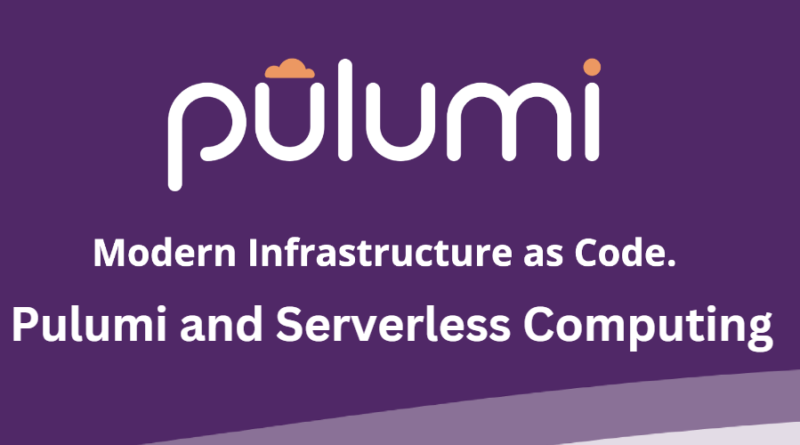Pulumi and Serverless Computing: Utilizing Pulumi to manage serverless functions and event-driven architectures.
Pulumi and Serverless Computing: Utilizing Pulumi to manage serverless functions and event-driven architectures
Serverless computing has gained significant popularity in recent years due to its ability to simplify infrastructure management and provide scalable and cost-effective solutions. Pulumi, an infrastructure as code (IaC) tool, offers robust capabilities for managing serverless functions and event-driven architectures. By leveraging Pulumi, developers can define, provision, and manage serverless resources and event-driven workflows using familiar programming languages and infrastructure-as-code practices.
Serverless computing enables developers to focus on writing and deploying code without the need to manage underlying infrastructure. Pulumi extends this paradigm by providing a declarative and programmatic approach to manage serverless resources and their configurations. This allows developers to define serverless functions, event sources, and their interactions in code, providing the benefits of infrastructure-as-code principles such as versioning, collaboration, and reproducibility.
Using Pulumi for serverless computing involves the following key aspects:
- Serverless Function Definition: With Pulumi, developers can define serverless functions using popular programming languages such as JavaScript, TypeScript, Python, or Go. These functions can be defined as separate modules or components that encapsulate the code and configuration required to implement specific business logic.
- Event Sources: Serverless functions are typically triggered by events from various sources such as message queues, object storage, databases, or HTTP endpoints. Pulumi allows developers to define and configure event sources, including setting up event subscriptions, configuring event triggers, and defining event-driven workflows.
- Resource Provisioning: Pulumi enables developers to provision and manage the necessary serverless resources, such as function apps, function containers, event hubs, or event grids. Developers can define the desired state of these resources in code and rely on Pulumi to handle the provisioning and management of the underlying infrastructure.
- Configuration and Environment Variables: Pulumi allows developers to specify configurations and environment variables required by serverless functions. These configurations can include settings such as memory allocation, timeout values, resource scaling, or connection strings. By managing these configurations as code, developers can ensure consistency and reproducibility across different deployments and environments.
- Deployment and Lifecycle Management: Pulumi supports seamless deployment and management of serverless functions and related resources. Developers can use Pulumi commands to initiate deployments, apply changes, and manage the lifecycle of serverless resources. Pulumi’s intelligent update engine ensures that only necessary changes are applied, reducing deployment time and minimizing disruptions.
- Integration with Other Services: Pulumi integrates with various cloud providers and services, enabling developers to leverage a wide range of capabilities and integrations. This includes integration with managed services such as message queues, databases, object storage, or notification services. By utilizing Pulumi’s integrations, developers can easily connect serverless functions with other services, enabling robust event-driven architectures.
Benefits of using Pulumi for serverless computing:
- Familiar Programming Languages: Pulumi allows developers to write serverless functions and infrastructure code using popular programming languages they are already familiar with. This reduces the learning curve associated with adopting new declarative languages specific to serverless deployments and enables the use of existing programming skills and tools.
- Infrastructure as Code: Pulumi enables infrastructure provisioning and management as code, providing the benefits of version control, collaboration, and reproducibility. Infrastructure configurations are treated as code artifacts, allowing teams to apply software engineering practices such as code review, testing, and continuous integration/continuous deployment (CI/CD) to their serverless deployments.
- Enhanced Developer Experience: By utilizing Pulumi’s language support, developers can leverage features such as type-checking, autocompletion, and refactoring in their serverless function definitions. These language features enhance code quality, catch errors early, and improve the overall development experience.
- Cross-Cloud Portability: Pulumi supports multiple cloud providers, including Amazon Web Services (AWS), Microsoft Azure, Google Cloud Platform (GCP), and Kubernetes. This cross-cloud portability enables developers to write serverless functions and event-driven architectures that can be deployed seamlessly across different cloud platforms, reducing vendor lock-in and providing flexibility.
- Policy Enforcement: Pulumi allows developers to define policies to enforce best practices, security controls, and compliance requirements for serverless deployments. Policies can be written in code, ensuring that the defined rules and constraints are consistently applied across serverless functions and related resources.
- Testing and Validation: Pulumi supports testing and validation of serverless functions and event-driven architectures. Developers can write tests that validate the behavior, inputs, outputs, and interactions of serverless functions. This ensures that serverless functions operate as expected, helping catch potential issues and improving the reliability of the overall system.
- Integration with CI/CD Pipelines: Pulumi integrates seamlessly with CI/CD pipelines, enabling automated deployments and ensuring that serverless functions and related resources are continuously delivered. By incorporating Pulumi commands into the CI/CD workflow, developers can automate the deployment and management of serverless resources, reducing manual effort and enabling faster time-to-market.
- Community and Ecosystem: Pulumi benefits from a vibrant and growing community that contributes to the ecosystem. Developers can leverage community-driven resources, examples, and best practices for serverless computing. The community-driven approach fosters knowledge sharing, collaboration, and innovation, making it easier for developers to adopt and succeed with Pulumi in their serverless deployments.
In summary, Pulumi provides a powerful and flexible approach to managing serverless functions and event-driven architectures. By leveraging familiar programming languages and infrastructure-as-code practices, developers can define, provision, and manage serverless resources in a declarative and reproducible manner. Pulumi’s integration with cloud providers, support for policies and testing, and seamless integration with CI/CD pipelines enable efficient and reliable serverless computing workflows. With Pulumi, developers can achieve the benefits of serverless computing while maintaining control, flexibility, and scalability in their infrastructure deployments.




